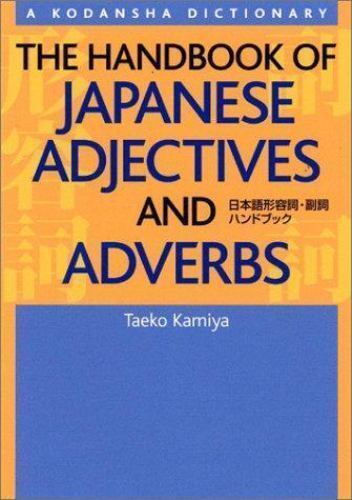Bild 1 von 9

Standardbild









Bild 1 von 9

Standardbild









The Handbook of Japanese Adjectives and Adverbs by Taeko Kamiya (2002, Trade Paperback)

UpNorth Mercantile (9415)
99,9% positive Bewertungen
Preis:
US $9,21
(inkl. MwSt.)
Ca.CHF 7,43
+ $23,68 Versand
Rücknahme:
30 Tage Rückgabe. Käufer zahlt Rückversand. Wenn Sie ein eBay-Versandetikett verwenden, werden die Kosten dafür von Ihrer Rückerstattung abgezogen.
Artikelzustand:
Oops! Looks like we're having trouble connecting to our server.
Refresh your browser window to try again.
Über dieses Produkt
Product Identifiers
PublisherKodansha America, Incorporated
ISBN-104770028792
ISBN-139784770028792
eBay Product ID (ePID)127383649
Product Key Features
Number of Pages320 Pages
LanguageEnglish
Publication NameHandbook of Japanese Adjectives and Adverbs
SubjectJapanese
Publication Year2002
TypeLanguage Course
AuthorTaeko Kamiya
Subject AreaForeign Language Study
FormatTrade Paperback
Dimensions
Item Height0.9 in
Item Weight13 Oz
Item Length5.1 in
Item Width7.1 in
Additional Product Features
Intended AudienceTrade
Dewey Edition22
TitleLeadingThe
Number of Volumes1 vol.
IllustratedYes
Dewey Decimal495.682421
SynopsisFor any beginner of Japanese, adjectives and adverbs are bound to present a challenge. Unlike English adjectives, Japanese ones conjugate, meaning that you must memorize their various forms before being able to build sentences of any complexity. Adverbs do not conjugate, but make use of particles to show their grammatical relationship to other words, and some have very subtle shades of meaning that are difficult to grasp. Moreover, many do not translate into adverbs in English. The role these parts of speech play in adding flavor to the Japanese language is invaluable. This handy reference manual introduces the basic (and basics of) adjectives and adverbs in a clear and sensible way, enabling students not only to speak Japanese but to do it with pizzazz. The book is divided roughly in half, the first half dealing with adjectives, the second with adverbs. Each is prefaced by a short introduction that serves as an overview of the material introduced. The section on adjectives is divided into two parts: Part 1 covers the conjugations of i- and na-adjectives and some basic auxiliary adjectives, and Part 2 presents common sentence patterns in which adjectives appear. The adverb section is arranged by topic. Among the types of adverbs explained here are those used to express time, quantity, degree, circumstance, and natural sounds or actions (the ubiquitous onomatopoeic adverbs). Each entry in this book is given a simple, concise English explanation and two or more example sentences to illustrate its usage. Exercises every few pages enable students to measure their understanding. Finally, a number of quick-reference lists in the appendixes provide a convenient means of recalling and building vocabulary. Together with its sister publication, The Handbook of Japanese Verbs, this unique manual is certain to provide years of friendly guidance., The only beginning-level grammar reference that explores adjectives and adverbs in depth. A must for all beginning and intermediate students of Japanese., For any beginner of Japanese, adjectives and adverbs are bound to present a challenge. Unlike English adjectives, Japanese ones conjugate, meaning that you must memorize their various forms before being able to build sentences of any complexity. Adverbs do not conjugate, but make use of particles to show their grammatical relationship to other words, and some have very subtle shades of meaning that are difficult to grasp. Moreover, many do not translate into adverbs in English. The role these parts of speech play in adding flavor to the Japanese language is invaluable. This handy reference manual introduces the basic (and basics of) adjectives and adverbs in a clear and sensible way, enabling students not only to speak Japanese but to do it with pizzazz. The book is divided roughly in half, the first half dealing with adjectives, the second with adverbs. Each is prefaced by a short introduction that serves as an overview of the material introduced. The section on adjectives is divided into two parts: Part 1 covers the conjugations of i- and na-adjectives and some basic auxiliary adjectives, and Part 2 presents common sentence patterns in which adjectives appear. The adverb section is arranged by topic. Among the types of adverbs explained here are those used to express time, quantity, degree, circumstance, and natural sounds or actions (the ubiquitous onomatopoeic adverbs). Each entry in this book is given a simple, concise English explanation and two or more example sentences to illustrate its usage. Exercises every few pages enable students to measure their understanding. Finally, a number of quick-reference lists in the appendixes provide a convenient means of recalling and building vocabulary. Together with its sister publication, The Handbook of Japanese Verbs , this unique manual is certain to provide years of friendly guidance., This is a complete guide to in-use Japanese adjectives and verbs for students at all levels. Appendices supply lists of sentence patterns, adjectives and adverbs that appear in the text, along with exercise answers. For any beginner of Japanese, adjectives and adverbs are bound to present a challenge. Unlike English adjectives, Japanese ones conjugate, meaning that you must memorize their various forms before being able to build sentences of any complexity. Adverbs do not conjugate, but make use of particles to show their grammatical relationship to other words, and some









